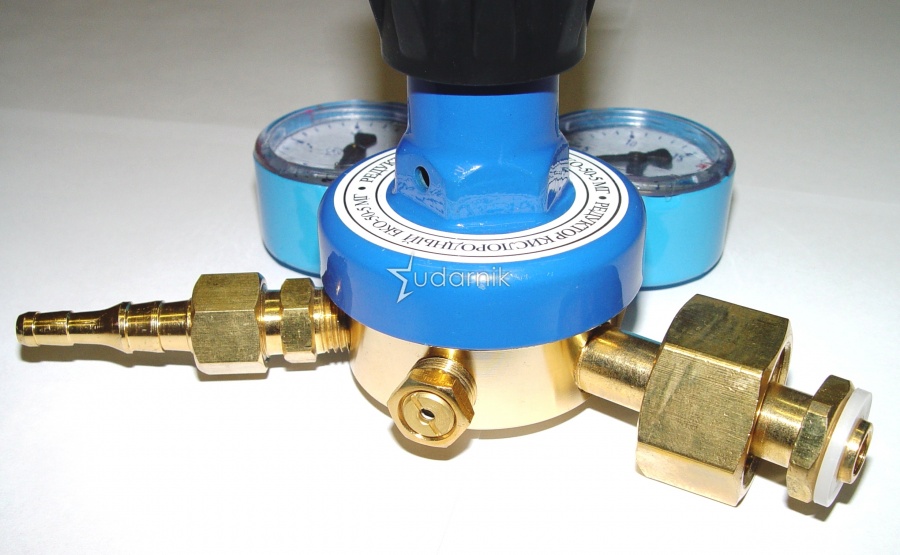To reduce the oxygen pressure in the tank when performing work by welding with gas acetylene, a BKO-50-4 reducer is used. This device reduces air flow, and also provides a stable indication of working pressure during welding operations.
Device
BKO-50-4 reducer is formed from:
- locking spring;
- inlet valve;
- pusher;
- membrane element;
- pressure spring and disc.
The most important component of the BKO is the intake valve. This part is constantly under the influence of two forces that affect in opposite directions. One vector is formed by the outgoing oxygen pressure in the cylinder, the second force is trying to squeeze the spring lock up so that the gas stream flows to the push rod. Synchronously with these processes, a second pressure indicator resists this pressure along with the membrane. As a result, the compartment with a reduced rate constantly maintains equal efforts guaranteed by the gearbox settings.
Operating principle
The oxygen reducer BKO-50-4 works as follows:
- Trying to lift the poppet element of the shut-off valve, the force from the pressure spring through the membrane tries to prevent this.
- With a decrease in working pressure, the spring pressure moves up, entraining the membrane element. The pusher comes out victorious in the fight against the locking spring and opens the inlet for gas that comes from the oxygen tank.
- In this case, oxygen consumption increases, and if the process occurs in the reverse order, it accordingly decreases. If the gearbox BKO-50-4 is adjusted correctly, dynamic synchronism is stably maintained between the indicated operations.
Correction of the apparatus in question consists in the fact that the tension force of the springs changes, if necessary. Most often, this factor is regulated by a fine screw. If this regulator is twisted, the spring weakens and the pressure decreases. Screwing a bolt increases pressure.
Technical characteristics of the gearbox BKO-50-4
General parameters of the device in question:
- maximum throughput - 50 cubic meters per hour;
- ultimate working pressure - 1.25 MPa;
- manufacturer - BAMZ;
- weight - 1.75 kg;
- working composition - oxygen;
- overall dimensions - 170/170/155 mm.
A standard set of gearbox BKO-50-4 for gas welding manipulations includes a pair of pressure gauges. One device controls the inlet pressure, the other takes readings after reduction. The devices under consideration are made in two versions: direct and reverse configuration. In the first case, the outgoing flow tries to open the valve, and in the reverse-action models, it is clogged by pressing the pusher against the landing seat.
Features
Depending on the pressure of the composition in the cylinder, which is equipped with an oxygen reducer BKO-50-4, the indicator changes in a parabola. The maximum indicator in the initial stage is important, it gradually decreases to the working level of the welding process, after which the gearbox is no longer needed.
An analogue of the reverse action is more efficient, as it ensures the stability of pressure indicators, regardless of the initial data on the oxygen residues in the tank, until it is completely empty. Nevertheless, a direct-acting device with a half-empty cylinder lowers the pressure, which is associated with a violation of the ratio of forces acting on the push member. Such units require constant adjustment by mechanical means (manually).
Varieties
The gearbox BKO-50-4, the characteristics of which are indicated above, according to its operational parameters is divided into two categories: ramp and post versions. The first models have improved throughput (100-120 cubic meters / h). In this regard, groups of oversized welding posts are used for power. Post analogs are aimed at personal value, show a flow rate of 5-25 cubic meters / h. The case parts of the devices under consideration are identical in appearance, so at the factory I cover them with different colors (the oxygen apparatus is painted in blue color).

The main technical characteristic of the specified unit is its throughput and pressure indication in the tank. The decoding BKO-50-4 indicates that the device is oriented for connection to a tank with oxygen. The device belongs to the group of single-stage devices, operates at nominal rates of up to 50 cubic meters per hour (throughput) and a standard pressure parameter of four atmospheres. It is the analogues of the BKO brand that are used for interaction in individual gas welding posts.
Operation Nuances
In this direction, the characteristics of the oxygen reducer BKO-50-4 have several nuances, namely:
- The number of stages of reduction. Single-stage modifications are used in which the pressure is regulated by a spring assembly. In two-stage counterparts, this procedure is corrected by means of pneumatic compartments in which the pressure is adjusted smoothly. The second option guarantees better work of the gas post if the indicators are stable in their parameters. In this case, the ambient temperature does not play a special role. Such models are more complex in design and more expensive.
- Type of connection. As a rule, they use a flare nut, not clamps. This is due to the fact that oxygen is explosive, requires a special approach to ensure tightness.
- Climatic fitness. If gas welding is performed at sub-zero temperatures, the requirements for the reliability of the BKO-50-4 gearbox increase. Oxygen, with a significant amount of work, quickly disappears, which provokes an increase in the capacity of the gas remaining in the balloon tank. The physical procedure helps to accelerate the cooling of the gas and the gearbox, as a result of which the device loses its working capacity.

Output
It is worth noting that a gearbox with two operating modes is fundamentally different from a single-stage analog. The main advantage is a valve with increased accuracy and a paired membrane with a larger working surface, made of reinforced synthetic rubber. This material is minimally sensitive to temperature extremes and pressure conditions within 150-200 atmospheres.